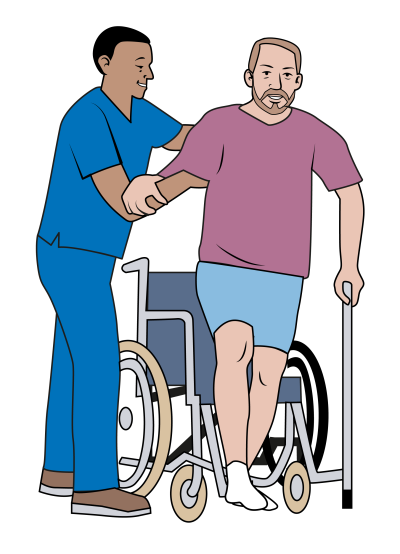It is common for a stroke to have resulted in physical changes affecting either the left or right side of your body. This may lead to difficulty in getting up, sitting, walking, and coordinating your hands. It can be physically and emotionally draining, especially for those who regarded themselves as previously being fit and active prior to their strokes. We hope the following information will be useful for all things physical.
Where can I find more information?
There are many ways that you can be affected physically after stroke. The Stroke Association provide a useful leaflet about the physical effects after stroke Click here for more information.

It is quite common to have weakness after a stroke, but it varies in severity, location and presentation. If the arm is very weak, care needs to be taken to prevent and stop injury because of the weight of the arm. Your physiotherapist or occupational therapist can provide advice on this. Stroke 4 carers also provide advice for carers to support the person they are caring for. More information on Stroke 4 carers.
Some people can develop high tone in their muscles after a stroke which can feel like tension. It feels as though the muscle cannot fully ‘switch off’ when it should be relaxed. Sometimes this tone can increase, and the muscle becomes tight. It is called spasticity. It may also be called unusual tightness or increased muscle tone. The condition can result in reflexes which become stronger or exaggerated. It can also affect walking, movement, speech, and many other activities of daily living.
This muscle tightness can lead to difficulties with pain, carrying out activities during the day, trying to maintain hygiene and possibly cause skin breakdown. Treatment for spasticity can include physiotherapy or occupational therapy, medication or splints. The Stroke Association’s pain after stroke leaflet provides additional information.
Following a stroke the positioning of your body and affected limbs, in bed and in sitting, is important. Good positioning can reduce the risk of tightening of muscles or tendons and provides a stable base for movement.
The type of chair or wheelchair required will depend on the level of support needed; please talk to an occupational therapist or physiotherapist for advice. Your GP or healthcare professional will be able to refer you to a local wheelchair provider, and powered options may be available.
You may need help to move from one position to another or from one surface to another after a stroke e.g. from a sofa to a wheelchair. It is important these are performed safely for the person and their carer.
For further information and advice on carrying out transfers, moving and handling safely ask your therapist for advice. If you do not have access to a a therapist the following advice may be helpful:
- Positioning for People Affected (Chest Heart & Stroke Scotland) Stroke
- Wheelchair Services -
- Leeds- (Leeds Teaching Hospitals NHS Trust)
- Wakefield (Wakefield Council)
- Moving and handling advice for Carers (Stroke4Carers).
The ability to walk and balance after a stroke will vary from person to person and can be affected by the following:
Muscle weakness / Coordination / Impaired sensation / Concentration / Vision /
Impaired spatial awareness / Vertigo /High blood pressure / Side effects of some medication
For further information and advice on balance and reducing your risk of falls, ask your physiotherapist for advice. If you do not have access to a physiotherapist the following advice may be helpful:
Further information on the physical effects of stroke can be found here:
- The Stroke Association -
- Different Strokes - Drop foot and Functional Electrical Stimulation (FES)
- Stroke4Carers - Advice for carers.
If you are already under the care of your local community stroke team, you can ask them more about this topic at your next visit.
Alongside more standard rehabilitation approaches offered in the NHS, some people find other approaches beneficial in managing their physical symptoms after stroke.
Iyengar yoga is a type of exercise that can be useful in helping you to relax and energise your body and mind. It can bring vitality, flexibility, strength, concentration, self-confidence and mental calm. It can also help overcome many stresses, strains, aches and pains and is particularly suitable for beginners whatever their ability, age, health or body shape. More information on iyengar yoga.
Why would you need a chiropractor? - Many people seek chiropractic care for symptoms such as chronic pain, fatigue, lack of energy, muscle aches, numbness, and tingling. These issues can be addressed with chiropractic care. More information and to find a Chiropractor.
Acupuncture is a treatment derived from ancient Chinese medicine. Fine needles are inserted at certain sites in the body for therapeutic or preventative purposes. It is used in many NHS GP practices, as well as in most pain clinics and hospices in the UK. Further information and to find an acupuncturist in the UK.
If you are already under the care of your local community stroke team, you can ask them more about this topic at your next visit.
Community based exercise and activities
See local directory pages
Private Therapy
Private therapy can be accessed by individuals either through medical insurance or by paying the provider directly. While private therapy can be received alongside NHS therapy, they are usually provided at different locations. If you are interested in this option, please consult a member of your NHS therapy team to coordinate care between both services. When considering private therapy, make sure the therapist is registered with the appropriate professional body and Health and Care Professions Council. Use the following resources to find and confirm the registration of private therapists.
- Health Care Professionals Council- Check the register
- Private treatment web page of the Stroke Association
- Private Physiotherapy – Physio2U section on CSP website. Search based on your location (postcode) and speciality that you require
- Private Occupational Therapy – search based on location and speciality that you require.